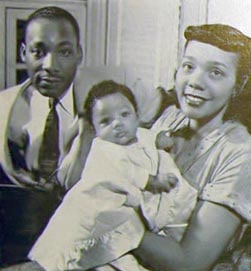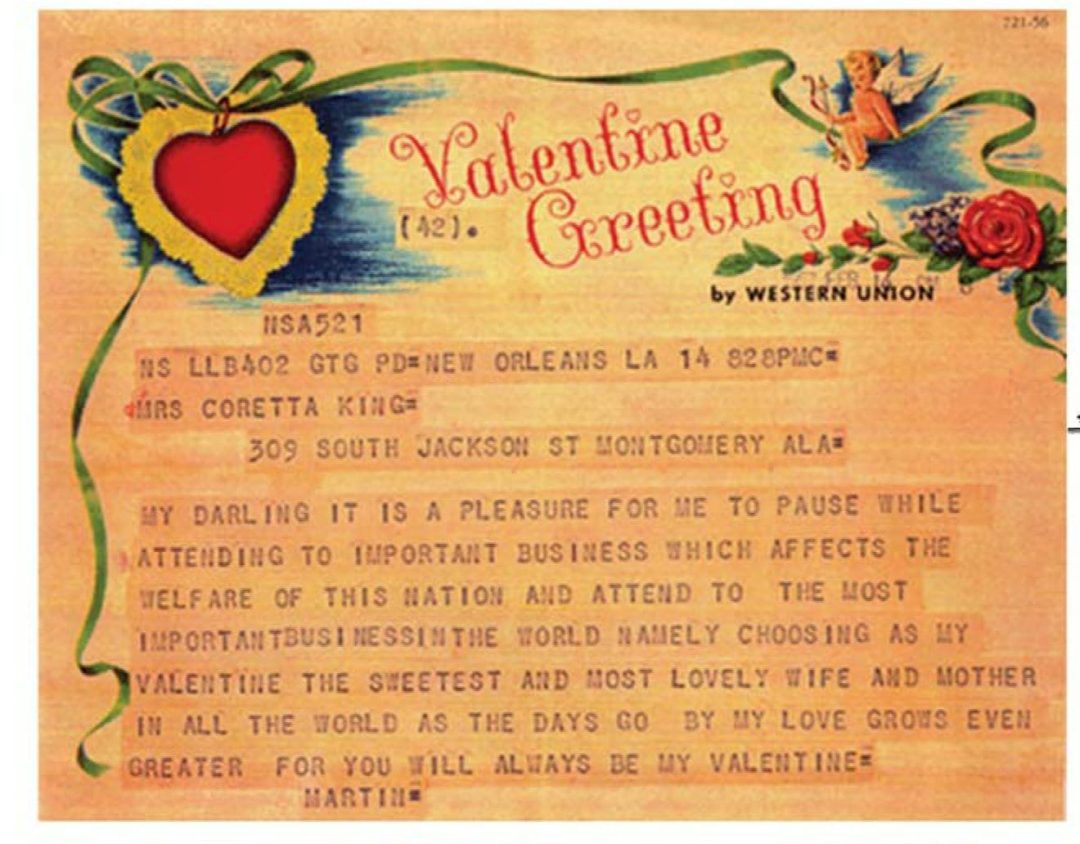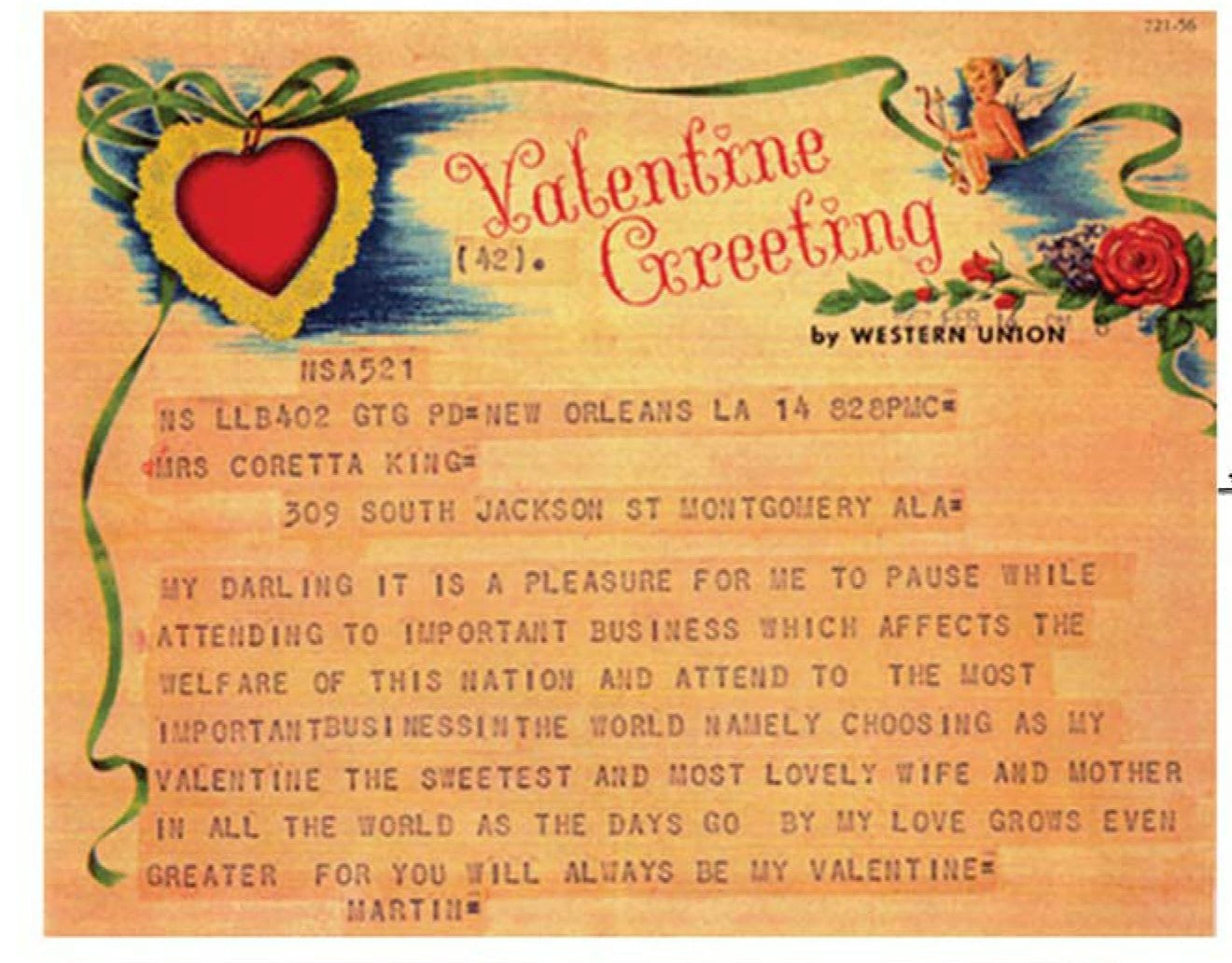With Valentine’s Day quickly approaching, I’ve spent some time looking into local love stories. And there’s a lot of them: Leah and Dooky Chase, Blue Lu and Danny Barker, and Antoinette and Ernie K-Doe are just a few I came across.
We live in a romantic city, but one story I didn’t expect had a connection to New Orleans was the love shared between Martin Luther King, Jr. and his wife, Coretta Scott King.
A telegram — written in New Orleans and sent on Valentine’s Day 1957 — gives a little more insight into their relationship.
The History
That Valentine’s Day, King and 96 other black religious leaders of 35 communities from 10 states met in Central City to build on their successes in the Montgomery bus boycott, and to plan their next steps in pressuring the federal government to act in favor of desegregation. They met inside the New Zion Baptist Church on Third and LaSalle streets where members officially founded a national organization — still in existence today: the Southern Christian Leadership Conference (SCLC).
View this post on Instagram
King was elected the organization’s first president that day. “Segregation,” he told the group in a closed-door session, “was a great cancer in the body politic.” And their mission was to end it.
He stepped away from the meetings that would ultimately lead to the SCLC’s March on Washington and King’s famous “I Have a Dream” speech, because — on this day — Martin had a more intimate message to deliver.
The Love Story
Coretta and Martin first met in Boston, when MLK — who was studying at Boston University — asked a friend at the New England Conservatory of Music if she knew any nice Southern girls. The friend asked Coretta, who — an activist, herself — wasn’t especially interested in dating preachers.

Coretta took her friend’s advice and agreed to chat with this potential suitor on the phone, but she wasn’t particularly impressed. During their conversation, King reportedly said, “I am like Napoleon at Waterloo before your charms,” to which Coretta replied, “You haven’t even met me.” On their first date, Coretta was less than awestruck, writing in her book, “My Life, My Love, My Legacy,” that, “He looked like a boy.”
But their relationship warmed as they went on dates in his green Chevrolet. King was convinced this woman he affectionately called “Corrie” was exactly what he wanted in a wife. They married in 1953 on the lawn of her parents’ home in Heiberger, Alabama, and had four children over the next decade.
When King stepped away from pivotal SCLC meetings in 1957 — meetings in New Orleans meant to force the reexamination of race relations in America — he went to a local Western Union to send a message of love and appreciation to his wife of four years. Here’s what that message said:

Mrs. Coretta King
309 South Jackson Street, Montgomery, Alabama
My darling it is a pleasure for me to pause while attending to important business which affects the welfare of this nation, and attend to the most important business in the world; namely choosing as my Valentine the sweetest and most lovely wife and mother in all the world. As the days go by, my love grows even greater for you will always be my Valentine.
– Martin
History Today
The incredible work of the activists at that New Orleans meeting — as well as those, like Coretta Scott King, who were not at the meeting — will reverberate throughout history for the rest of humanity.
Evidence of what they started can also still be found locally. New Zion Baptist Church, where the meetings were held, is still where it was when MLK visited the city. The SCLC’s New Orleans chapter is also still in existence and offers programming we can learn from and enjoy.
Finally, Felicity Redevelopment, Inc. has worked for years to transform the park across from the church into the SCLC Park Pavilion. The space is open to the public and — through works created by the award-winning artist, Jessica Strahan — remembers the momentous history that took place on this block, as well as the contributions of the national, state, and local civil rights leaders who helped make it so. Additions are still being made to the pavilion — including verbiage about each person represented there — but it’s certainly worth a visit as is.
View this post on Instagram







